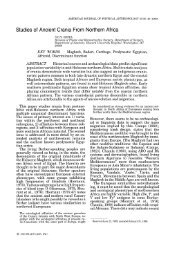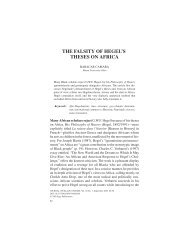Dutch Slavery and Slave Trade in the Indian Ocean
Dutch Slavery and Slave Trade in the Indian Ocean
Dutch Slavery and Slave Trade in the Indian Ocean
Create successful ePaper yourself
Turn your PDF publications into a flip-book with our unique Google optimized e-Paper software.
136 journal of world history, june 2003<br />
problematic nature of <strong>the</strong> term “slave” <strong>in</strong> an <strong>Indian</strong> <strong>Ocean</strong> context, 12<br />
its special characteristics <strong>in</strong>cluded property or chattel status <strong>and</strong> <strong>the</strong><br />
ensu<strong>in</strong>g potential of re-isolation, <strong>in</strong>stitutionalized coercion <strong>and</strong> systemic<br />
exploitation, outsider status or essential k<strong>in</strong>lessness def<strong>in</strong>ed as<br />
“social death,” <strong>and</strong> lack of control over physical reproduction <strong>and</strong> sexuality.<br />
13<br />
Two basic systems of <strong>Indian</strong> <strong>Ocean</strong> slavery can be dist<strong>in</strong>guished.<br />
The “open system” of slavery could be found <strong>in</strong> <strong>the</strong> commercialized,<br />
cosmopolitan cities of Sou<strong>the</strong>ast Asia <strong>and</strong> elsewhere where <strong>the</strong> boundary<br />
between slavery <strong>and</strong> o<strong>the</strong>r forms of bondage was porous <strong>and</strong> <strong>in</strong>dist<strong>in</strong>ct<br />
<strong>and</strong> upward mobility was possible. In <strong>the</strong> “closed systems” of<br />
South (<strong>and</strong> East) Asia, with some notable exceptions, it was <strong>in</strong>conceivable<br />
for a slave to be accepted <strong>in</strong>to <strong>the</strong> k<strong>in</strong>ship systems of <strong>the</strong>ir<br />
owners as long as <strong>the</strong>y rema<strong>in</strong>ed slaves because of <strong>the</strong> stigma of slavery;<br />
<strong>in</strong>stead <strong>the</strong>y were ma<strong>in</strong>ta<strong>in</strong>ed as separate ethnic groups. The term<br />
“slave” here <strong>in</strong>cludes so-called “true slaves,” those recently captured<br />
<strong>and</strong> sold <strong>in</strong> open systems, <strong>and</strong> those <strong>in</strong> closed systems of slavery, along<br />
with all o<strong>the</strong>r forms of bondage <strong>and</strong> ties of vertical obligation. 14<br />
This article discusses various aspects of <strong>Dutch</strong> slavery <strong>and</strong> slave<br />
12 David Brian Davis observed: “The more we learn about slavery, <strong>the</strong> more difficulty<br />
we have def<strong>in</strong><strong>in</strong>g it,” (<strong><strong>Slave</strong>ry</strong> <strong>and</strong> human progress, [New York, 1984]). For <strong>the</strong> <strong>Indian</strong> <strong>Ocean</strong>,<br />
see A. Reid, Sou<strong>the</strong>ast Asia <strong>in</strong> <strong>the</strong> Age of Commerce, 1450–1680, Volume One: The L<strong>and</strong>s<br />
below <strong>the</strong> W<strong>in</strong>ds (New Haven <strong>and</strong> London, 1988), p. 132; B. Ste<strong>in</strong>, “<strong><strong>Slave</strong>ry</strong> <strong>and</strong> Serfdom<br />
<strong>in</strong> South Asia,” <strong>in</strong> A.T. Embree, ed., Encyclopedia of Asian History (New York, 1988), III,<br />
p. 490; U. Chakaravarti, “Of Dasas <strong>and</strong> Karmakaras: <strong>Slave</strong> Labour <strong>in</strong> Ancient India,” <strong>in</strong> U.<br />
Panaik <strong>and</strong> M. D<strong>in</strong>gawaney, eds., Cha<strong>in</strong>s of Servitude: Bondage <strong>and</strong> <strong><strong>Slave</strong>ry</strong> <strong>in</strong> India (Madras,<br />
1985), pp. 35, 36–37, 48; T. Raychaudhuri <strong>and</strong> I. Habib, eds., The Cambridge Economic History<br />
of India, Volume I: c. 1200–1750 (New York, 1982), pp. 30–32, 92–93, 530; M. I. F<strong>in</strong>ley,<br />
“Between <strong><strong>Slave</strong>ry</strong> <strong>and</strong> Freedom,” Comparative Studies <strong>in</strong> Society <strong>and</strong> History 6 (1963–64),<br />
p. 23; J. L. Watson, “<strong><strong>Slave</strong>ry</strong> as an Institution: Open <strong>and</strong> Closed Systems,” <strong>in</strong> J. L. Watson,<br />
ed., Asian <strong>and</strong> African Systems of <strong><strong>Slave</strong>ry</strong> (Oxford, 1980), pp. 12–13; A. Schottenhammer,<br />
“<strong><strong>Slave</strong>ry</strong> <strong>in</strong> Late Imperial Ch<strong>in</strong>a (17th /18th to early 20th century),” unpublished paper<br />
presented at <strong>the</strong> International Conference on <strong><strong>Slave</strong>ry</strong>, Unfree Labor <strong>and</strong> Revolt <strong>in</strong> Asia<br />
<strong>and</strong> <strong>the</strong> <strong>Indian</strong> <strong>Ocean</strong> Region, University of Avignon, 4–6 October 2001.<br />
13 Classical statements <strong>in</strong>clude O. Patterson, <strong><strong>Slave</strong>ry</strong> <strong>and</strong> Social Death: A Comparative<br />
Study (Cambridge, Mass., 1982); M. I. F<strong>in</strong>ley, “<strong><strong>Slave</strong>ry</strong>,” International Encyclopedia of <strong>the</strong><br />
Social Sciences 14 (New York, 1968), pp. 307–13; H. J. Nieboer, <strong><strong>Slave</strong>ry</strong> as an Industrial System:<br />
Ethnological Researches, 2nd ed. (The Hague, 1910); Watson, “<strong><strong>Slave</strong>ry</strong> as an Institution,”<br />
pp. 3, 8; P. E. Lovejoy, Transformations <strong>in</strong> <strong><strong>Slave</strong>ry</strong>: A History of <strong><strong>Slave</strong>ry</strong> <strong>in</strong> Africa (New<br />
York, 1983), p. 1.<br />
14 Watson, “<strong><strong>Slave</strong>ry</strong> as an Institution,” pp. 9–13; A. Reid, “‘Closed’ <strong>and</strong> ‘Open’ <strong>Slave</strong><br />
Systems <strong>in</strong> Pre-Colonial Sou<strong>the</strong>ast Asia,” <strong>in</strong> A. Reid, ed., <strong><strong>Slave</strong>ry</strong>, Bondage <strong>and</strong> Dependence<br />
<strong>in</strong> Sou<strong>the</strong>ast Asia, pp. 156–67. The <strong><strong>Slave</strong>ry</strong> Convention signed at Geneva <strong>in</strong> 1926<br />
(approved by <strong>the</strong> United Nations by protocol <strong>in</strong> 1953) def<strong>in</strong>es slavery as “<strong>the</strong> status or condition<br />
of a person over whom any or all of <strong>the</strong> powers attach<strong>in</strong>g to <strong>the</strong> right of ownership<br />
are exercised.” The slave trade <strong>in</strong>cludes “all acts <strong>in</strong>volved <strong>in</strong> <strong>the</strong> capture, acquisition or dis-




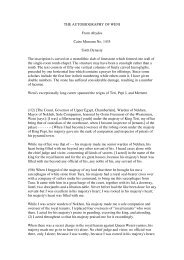
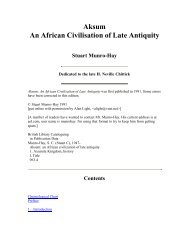
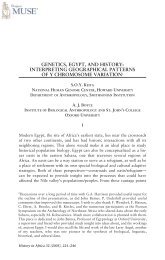

![The Negro trail blazers of California [microform] : a ... - Homestead](https://img.yumpu.com/32436613/1/174x260/the-negro-trail-blazers-of-california-microform-a-homestead.jpg?quality=85)

